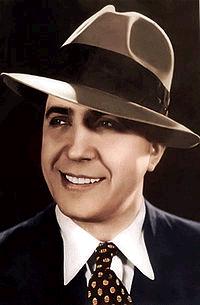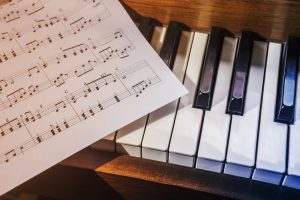Table of Contents
Remembering Carlos Gardel (1890-1935)

Best Sheet Music download from our Library.
Carlos Gardel (short bio)
Carlos Gardel (Tolosa, December 11, 1890 – Medellin, June 24, 1935) was a singer, composer and film actor. He is the most well-known representative of the genre in the history of tango. Initiator and greatest exponent of the ‘tango song’, he was one of the most important performers of world popular music in the first half of the 20th century, for the quality of his voice, for the number of records sold (as a singer and as a composer), for the numerous films related to tango in which he took part and for the worldwide repercussion he had.

There is no unanimity in the place and date of his birth. The Uruguayan theory holds that he was born in Tacuarembó, Uruguay, on December 11 between 1883 and 1887. The French theory, on the other hand, holds that he was born in Toulouse, France, on December 11, 1890. There is unanimity in the fact that he lived from childhood in Buenos Aires and that he became an Argentine national in 1923. He died on June 24 of 1935 in Medellín, Colombia, in an air accident.
The person and image of Gardel has been the object of popular idolatry, especially in Argentina and Uruguay, which have placed him in a place of myth and cultural symbol that still maintains its validity. In 2003, Gardel’s voice was registered by Unesco in the Memory of the World program, dedicated to the preservation of heritage documents.
Please, subscribe to our Library.
If you are already a subscriber, please, check our NEW SCORES’ page every month for new sheet music. THANK YOU!
Facts that maybe you didn’t know about Carlos Gardel
On June 24, 1935, at the age of 44, on the asphalt of the airport in Medellín, Colombia, the voice of the greatest exponent of the Argentinian music went out: Carlos Gardel. He was a singer, composer and film actor, and his audience knew him as Carlitos, El Zorzal Criollo, El Morocho del Abasto, El Mago, El Rey del Tango, El Mudo or El Troesma.

With a particular voice, more than 900 recordings of tango and other musical styles such as folklore, milongas and rancheras, a large number of records sold, movie tickets sold and his compositions gave him worldwide recognition. Even today, 84 years after his death, the phrase that best describes him is still latent: ‘Every day he sings better.’
“Volver”, “Por una Cabeza”, “Caminito”, “Cuesta Down”, “The Day You Love Me” and “My Buenos Aires Dear” are examples of his success. Countless versions of some of its songs have been made by the most renowned performers of various genres.

Before leaving
On March 28, 1935, he began a Latin American tour from New York that took him to Puerto Rico, Venezuela, Aruba, Curacao, Colombia, Panama, Cuba and Mexico. He is accompanied, among others, by Alfredo Le Pera (author of the lyrics of many of his tangos), his guitarists Guillermo Barbieri, José María Aguilar and Angel Domingo Riverol.
Medellín hails him and all of Colombia calls him “The King of Tango”. Predictably, a brochure published in Bogotá bears the title “Last days of Carlos Gardel”, written by the Colombian theater entrepreneur Nicolás Diaz, who promoted his performance in the capital city.
At 11 in the morning on Monday, June 24, 1935, Gardel and his traveling companions met in the rooms of the Hotel Granada, ready to leave for Cali on an express plane. Gardel was more happy, active and mobile than anyone else because he was anxiously awaiting the end of that tour to later return to Argentina, where he wanted to form his own production company. A crowd gathered at the doors of the hotel and photographers took what would be their last photos.
A crash of two planes at the Medellín airport cut short the last presentation of the tour and the expected return of Carlos Gardel to Argentina. The plane in which Gardel was traveling, a Ford trimotor from the SACO company, deviated in the middle of the takeoff taxi and hit another similar plane from the German company SCADTA, which was waiting its turn to take off, both catching fire. The court decided that the causes of the accident were due to the characteristics of the runway and a strong wind coming from the southeast.
French, Uruguayan or Argentine?
There is no unanimity about the birthplace of Carlos Gardel. The Uruguayan version maintains that he was born in Tacuarembó (Uruguay), while the French version, and the most recognized, claims that he was born in Toulouse, France. What is certain is that he lived his childhood in Buenos Aires and in 1923 he became an Argentine national. His real last name was Gardes and he converted it to Gardel. He settled, along with his mother, in the old house on Uruguay Street, between Cangallo (today Presidente Perón) and Cuyo (Sarmiento) with a wide patio and iron gate.
Your first steps
Carlitos walked around the stages, he went on stage among the guests and passers-by, he went up and down sets, he walked around the props, taking furniture on stage and bringing it on stage, while he accompanied with his voice what the orchestra was playing. In the “O’Rondemán” café, on Agüero and Humahuaca, in front of the Mercado del Abasto, he met with his friends and began to sing before the public.
In 1911 he met the Uruguayan José Razzano, at a friend’s house located on Guardia Vieja Street. The figure of Gardel begins to be familiar to all the people around El Abasto, along with his songs. His song was the serenade of the entire neighborhood. Years later that part of the street, between Jean Jaurés and Anchorena, would be renamed Carlos Gardel Passage.
The albums
The first recording was as a member of the Gardel-Razzano duo and was made on April 9, 1917 in a mansion next to the Savoy hotel, on Cangallo street (today Presidente Perón), near the corner of Callao. That first phonograph record had a Creole song on each of its sides: “Cantar siempre”, by Angel Villoldo and “Entre Colores.”
The appearance of Gardel-Razzano’s records marks the beginning of the growing demand for these reproductions and the subsequent hiring of other performers of popular music and songs as well as the flourishing of this industry.
Gardel and tango
Gardel learns the tango composed by his friend José María Contursi and sings it in private gatherings with a skatey tonality and a honeyed nostalgia that reaches the hearts, but he does not dare to sing it in front of the public. Journalists and theater men were enthusiastic about hearing it and decided to premiere it at the Teatro Esmeralda, where he sang “Mi noche triste” and it was a success.
Why did he sing better every day?
Carlos Gardel, a few years after his triumphant beginning, had the concern of studying singing. Those classes instilled in him the diction of the emphasized ‘es’ and the ‘es’ and ‘enes’ altered in the ‘Eres’ that he acquired and that so many imitators of his song copied. From singing studies he extracted a technique that effortlessly regulated the emission of the voice.
Barcelona fan and turf fan
Carlitos Gardel became a soccer fan in Catalonia. He stole the soul of the Barcelona players when, after a match for the final of the Spanish championship, against Real Madrid, he went to sing to the injured players in the infirmary.
The first radio audition
The Gardel-Razzano duo made, by special request, the first transmission from Radio Splendid, in the early days of radiotelephony. This helps promote the public’s love for radio. His last radio intervention, live, was in 1933, from Radio Belgrano, before what would have been his definitive departure from Buenos Aires.
Later it could be heard from New York, carried out through Radio Splendid, with the originality of the accompaniment of the guitarists from Buenos Aires and on Radio Belgrano through the magazine Canción Moderna (ex Radiolandia).
He never filmed a movie in Argentina
On a trip to Europe in 1930, Gardel suggested to the playwrights Manuel Romero and Luis Bayón Herrera that they film a film with an Argentine theme. They write the plot of “Luces de Buenos Aires”, starring Gardel with prominent roles by Sofía Bozán and Pedro Quartucci. Filming took place on the sets that the Paramount company had in Joinville, near Paris, but no scenes were filmed in Argentina.
Gardel and the cinema
Due to its success, the company sent copies to other countries. In Spain and America the public interrupted the showing of the film, after Gardel sang the tango “Tomo y obligo”, asking to hear it again. An event that has never occurred in the history of cinema.
In 1932 Paramount hired him for two more productions. In the same studios he filmed “Melodía de Arrabal” and later, in New York, “Cuesta Abajo”. He was later hired for three more films: “Tango on Broadway,” “El día que me siempre” and “Tango Bar.”
Rockefeller Center: Gardel worked here
On the walls and columns of the Ground Floor of Rockefeller Center in New York you can read the history of the building, inaugurated in 1933 and previously called “The RCA Building”. The famous NBC network has its place in the building and the image of Carlos Gardel accompanies the history of NBC. The reason is that when Gardel signs his contract with NBC, he does so from this building. There Gardel’s career began to recover after the closure of the Paramount studios in France the previous year.
The video clips
Carlos Gardel can be considered a precursor in the making of sound music video clips or short films, as they were known at that time. In 1930 Gardel starred in fifteen, each about a song, directed by Eduardo Morera and produced by Federico Valle, but ten were released, since five were ruined in the laboratory. They are: The carter, Longing, Autumn roses, Hand in hand, Yira yira, I’m afraid, Padrino pelao, Enfundá la mandolin, Canchero and Viejo tuxedo.
The jealous stars
Gardel was always reserved in his privacy. His first teenage love affair was in Buenos Aires with a girl who lived in Abasto. It is also said that there was a girlfriend whom he always dreamed of making his wife but, due to his career, he could not make it happen. This girlfriend met him on trips to Europe. In his private correspondence there is a relationship with Isabel del Valle, a 13-year-old girl, with whom Gardel had a relationship in 1920 and with whom he maintained an ambiguous relationship until 1933.
Descarga las mejores partituras de nuestra biblioteca.
Por una Cabeza – Carlos Gardel
“Por una cabeza”, is one of the most famous and popular tango songs by Carlos Gardel (composer) and Alfredo Le Pera (lyricist), written in 1935.
Browse in the Library:
Or browse in the categories menus & download the Library Catalog PDF:
